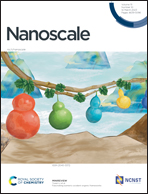Growth of 1D ClAlPc molecular chains mediated by graphene moiré patterns†
Abstract
The on-surface formation of iso-oriented 1D molecular architectures, with high structural perfection, on 2D materials has been a long-sought objective. However, such realization has been troublesome and limited, and it still remains an experimental challenge. Here, the quasi-1D stripe-like moiré pattern, arising at the interface of graphene grown on Rh(110), has been used to guide the formation of 1D molecular wires of π-conjugated, non-planar, chloro-aluminum phthalocyanine (ClAlPc) molecules, brought together by van der Waals interactions. Using scanning tunnelling microscopy (STM) under ultra-high vacuum (UHV) at 40 K, the preferential adsorption orientations of the molecules at low coverages have been investigated. The results shed light on the potential signature of graphene lattice symmetry breaking, induced by the incommensurate quasi-1D moiré pattern of Gr/Rh(110), as the subtle mechanism behind this templated growth of 1D molecular structures. For coverages close to 1 ML, the molecule–molecule interactions favor a closely packed square lattice arrangement. The present work provides new insights to tailor 1D molecular structures on graphene grown on a non-hexagonal metal substrate.



 Please wait while we load your content...
Please wait while we load your content...